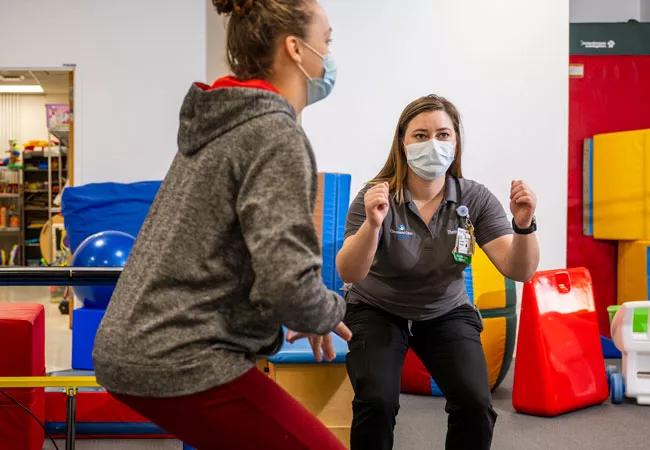6 objective measures to assess pain and evaluate progress

By Ethan Benore, PhD and Heidi Kempert, PTA
Advertisement
Cleveland Clinic is a non-profit academic medical center. Advertising on our site helps support our mission. We do not endorse non-Cleveland Clinic products or services. Policy
The International Association for the Study of Pain defines pain as “an unpleasant sensory and emotional experience associated with or resembling that associated with actual or potential tissue damage.” Symptoms of chronic pain typically last at least three months, although, in our population, children suffer at least one to two years before discovering our rehabilitation program.
Common conditions of chronic pain that benefit from rehabilitation include chronic migraine, back pain, abdominal pain, amplified musculoskeletal pain syndrome, postural orthostatic tachycardia syndrome, Ehlers-Danlos syndrome (or hypermobility syndrome), and complex regional pain syndrome. These children struggle with day-to-day activities, such as attending school, socializing with friends, participating in sports or after school activities and holding jobs. Most develop significant deconditioning and impaired activities of daily living (ADLs). These functional impairments often require intensive interdisciplinary pain treatment (IIPT), a well-established form of pain rehabilitation.
When evaluating the severity of impairment in chronic pain, most researchers use self-report measures. However, cognitive factors, such as broad overgeneralizations of impairment and poor insight, can greatly impact subjective ratings by capturing more than just a child’s physical performance. There is a lack of sound objective measurement to quantify a child’s struggle with chronic pain and gains made from pain rehabilitation. While some objective measures exist, these are not easily performed in a rehabilitation setting and lack face validity for children and families.
Advertisement
The aim of this study was to evaluate functionally relevant physical exercises to assess children’s day-to-day functioning with chronic pain as well as improvement in functioning after a course of pain rehabilitation.
A subset of 207 children from our clinic were evaluated using our clinical database that captures functional impairment and response to treatment in the entire population referred for pain rehabilitation. In this subset, children were also provided with functionally relevant physical exercises as well as existing subjective measures of functioning, which have demonstrated validity and a positive response to pain rehabilitation.
After initial assessment, children participated in three weeks of intensive interdisciplinary rehabilitation, including three to four hours daily of physical and occupational therapy, six hours per week of psychology and a range of other therapeutic programs (e.g., recreation therapy, school services, music therapy and biofeedback).
The objective exercises performed included carrying a box, lifting a box from floor-to-waist and waist-to-eye, transitioning from the floor to a standing position, transitioning from a sitting to a standing position, step-up exercises and walking for six minutes. All were easy to administer within the existing program and made sense to children and families of the functional impairments they experience at home and in the community.
The study results supported our hypotheses. Children demonstrated significant improvement in functioning over the course of pain rehabilitation. This was measured both by existing valid self-report measures as well as all seven of our objective measures. Pain did not change from admission to discharge significantly; this is expected as existing research supports that subjective reports of pain typically improve after a sustained improvement in functioning. Additionally, we noted a strong correlation between two separate subjective measures of functioning, while the correlations between subjective and objective measures were moderate at admission and weak at discharge. This indicates that subjective measures together capture other cognitive or emotional factors that are isolated out in objective assessments. While these cognitive factors may be relevant to pain intervention, there is benefit to isolate objective performance.
Advertisement
This study helps to further research and clinical care in children with chronic pain by demonstrating the utility of objective measures to: 1) assess functional impairment as well as 2) demonstrate response to rehabilitation. It also highlights the difference between subjective and objective measures, which may open new lines of research in evaluating the impact of pain interventions. These exercises are now included as standard measurement in our programming. We are now interested in further evaluating how improvements in objective measures may mediate or influence the other subjective measures that are more commonly recorded in this population.
References
Advertisement
About the authors: Heidi Kempert, PTA is a physical therapy assistant who has worked in pediatric chronic pain for over 10 years. She has published several articles on innovative methods for physical therapy to improve the lives of children with chronic pain.
Ethan Benore, PhD, BCB, ABPP is Chair of the Division of Psychology at Cleveland Clinic Children’s and Clinical Director of the Pediatric Pain Rehabilitation Program. He has worked with this population for over 20 years with a focus on clinical outcomes assessment and biofeedback or other innovative interventions to support children with chronic pain.
Advertisement
Advertisement

Case-control study yields evidence of epigenetic aging in pediatric-onset MS

Leaders of the Pediatric Cancer Committee discuss new accreditation

Relapse rates were lower with oral or infusion therapy after initial injectable DMT

Evidence, clinical considerations, and why more research is still needed

Multidisciplinary team coordinates, adds efficiencies to care

Compassion, communication and critical thinking are key

Add AI to the list of tools expected to advance care for pain patients

Cleveland Clinic study investigated standard regimen